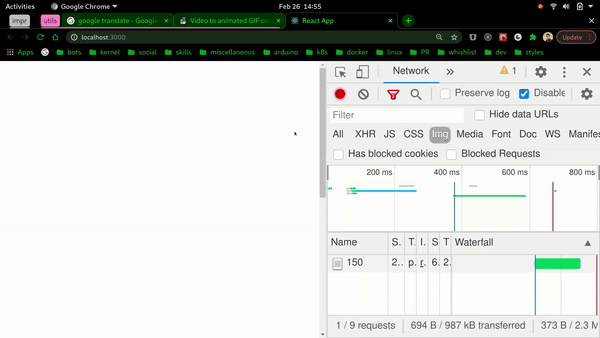Lazy Loading Image - [2/2]

Francesco Di Donato
Posted on March 1, 2021
![Lazy Loading Image - [2/2]](https://media2.dev.to/dynamic/image/width=1000,height=420,fit=cover,gravity=auto,format=auto/https%3A%2F%2Fdev-to-uploads.s3.amazonaws.com%2Fuploads%2Farticles%2Fb1s4ixcmq6nmah3qnq8f.png)
Recap
In the previous post, I built a React component Image that receives two sources, one for a low-resolution version of the image and one for the high-resolution one. Shows the former, which is promptly replaced by the latter as soon as its download is complete.
Abstract
A further performance improvement is to start the download of the high-resolution image only when the component is in view.
Still, with a view to modern React, I build a custom hook which, having received a ref associated with an HTML element, uses the IntersectionObserver API to evaluate if the element is in view
Process
I add the hook in the appropriate folder built previously
touch src/hooks/useIntersectionObserver.js
The IntersectionObserver must be instantiated in a useEffect whose execution depends on the elementRef that the hook receives as an argument. This is necessary for the functionality of the hook to be responsive if a different ref is conditionally provided during use
One way to proceed is to bind the IntersectionObserver to a ref declared in the hook itself. In this way, at the unmount of the component using the hook, React will take care of the clean up of the aforementioned ref
In the IntersectionObserver callback it is sufficient to set the entry that is observed. This makes it easy to find outside the useEffect
useIntersectionObserver.js
import { useRef, useEffect, useState } from 'react'
const useIntersectionObserver = elementRef => {
const observer = useRef()
const [entry, setEntry] = useState()
const options = {
threshold: 0.1,
root: null,
rootMargin: '0%',
}
const updateEntry = entries => {
setEntry(entries[0])
}
useEffect(() => {
const node = elementRef?.current
if (!node) return
if (observer.current) observer.current.disconnect()
observer.current = new IntersectionObserver(updateEntry, options)
const { current: currentObserver } = observer
currentObserver.observe(node)
return () => currentObserver.disconnect()
}, [elementRef])
return { isVisible: !!entry?.isIntersecting, entry }
}
export default useIntersectionObserver
A boolean is returned indicating the presence or absence of the component in the view
There are two
observer.current.disconnect(). The first is executed only if the observer was already active but under observation on a differentelementRef. In the second case, the disconnection occurs in the cleanup phase of theuseEffectwhich, by extension, uniquely corresponds to the moment in which the component that makes use of the hook is removed from the DOM
For the purposes of this demo the hook always refers to the whole view. However, it is not difficult to take a second
optionsargument and pass it into the IntersectionObserver instance (remember to add it to theuseEffectdependencies)
The use in the <Image> component (the same as in the previous post) is immediate. I declare a ref (imageRef) and bind it to the root element of the component (div.wrapper). The same ref is supplied to the useIntersectionObserver hook which returns isVisible
Conditionally showing the second <img> tag, that is the one associated with the high-resolution image, you will get that the feature implemented in the previous post is used only when the element enters view. In the meantime, the user is shown the low-resolution image
Image.js (* to indicate the changes from the previous one)
import { useRef } from 'react'
import useImageOnLoad from '../hooks/useImageOnLoad'
import useIntersectionObserver from '../hooks/useIntersectionObserver'
const Image = ({ width = '100%', height = '100%', lowResSrc, highResSrc }) => {
const { handleImageOnLoad, transitionStyles } = useImageOnLoad()
const imageRef = useRef() // *
const { isVisible } = useIntersectionObserver(imageRef) // *
const styles = {
wrapper: {
position: 'relative',
width,
height,
},
image: {
position: 'absolute',
width: '100%',
height: '100%',
objectPosition: 'center center',
objectFit: 'cover',
},
}
const lowResStyle = {
...styles.image,
...transitionStyles.lowRes,
}
const hightResStyle = {
...styles.image,
...transitionStyles.highRes,
}
return (
<div style={styles.wrapper} ref={imageRef}>
<img src={lowResSrc} style={lowResStyle} />
{isVisible && ( // *
<img
src={highResSrc}
style={hightResStyle}
onLoad={handleImageOnLoad}
/>
)}
</div>
)
}
export default Image
The simplest way to check if the desired effect is present is to move the image outside the screen
App.js (detail)
<div style={{ position: 'relative', height: '200vh' }}>
<div style={{ position: 'absolute', bottom: 0 }}>
<ImageIO
width={600}
height={400}
lowResSrc={srcTuple[0]}
highResSrc={srcTuple[1]}
/>
</div>
</div>
From the Network tab of the Developer Tools, you can see how the low-resolution image download is performed as soon as possible. On the other hand, that of the high-resolution image is started only when the component is in view
Thanks for reading, continue to the next post (work in progress)

Posted on March 1, 2021
Join Our Newsletter. No Spam, Only the good stuff.
Sign up to receive the latest update from our blog.
